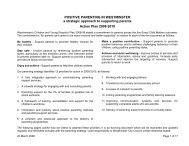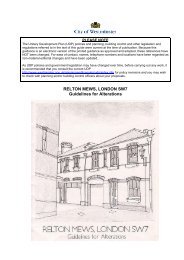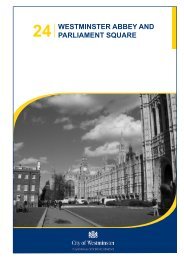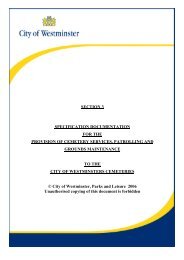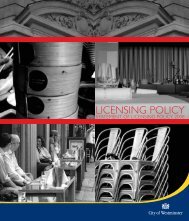Westminster Open Spaces Noise Study 2008 Final Report
Westminster Open Spaces Noise Study 2008 Final Report
Westminster Open Spaces Noise Study 2008 Final Report
- No tags were found...
You also want an ePaper? Increase the reach of your titles
YUMPU automatically turns print PDFs into web optimized ePapers that Google loves.
<strong>Westminster</strong> <strong>Open</strong> <strong>Spaces</strong> <strong>Noise</strong><strong>Study</strong> <strong>2008</strong>: <strong>Final</strong> <strong>Report</strong>7. Recommendations for Protection and Enhancement7.1.1 This section contains a subjective description of noise sources and the noise climate ofeach site visited during this project, together with recommendations as to possible actionswhich may help to protect or enhance this noise climate.7.1.2 These recommendations also need to be considered in the light of other council policies,and cost implications, as non-acoustical factors may limit their usefulness andeffectiveness. A detailed investigation, consultation with appropriate <strong>Westminster</strong> officers,and possible further refinement of proposals would be required prior to implementation ofthese recommendations. There are a number of references to water features as pleasantnatural sounds. It is recognised that water features are relatively expensive to build andmaintain and may not be appropriate for certain spaces. For some of these spaces othermasking sounds may be appropriate.Riverside Walk Gardens7.1.3 Traffic noise from the adjacent busy road was dominant with distinctive contributions fromvehicle horns, heavy vehicles and emergency sirens. Squealing of heavy vehicle brakeswas also significant. Wind noise along the river was apparent on the monitoring day.7.1.4 If practical, traffic calming measures may reduce noise levels along with ensuring goodmaintenance of the bus fleet to reduce noise from bus brakes. Road signs stating that thisis a quiet area with no use of car horns may help.Ebury Gardens7.1.5 The dominant noise sources were transport based – local and distant road traffic andaircraft noise. Traffic calming on the local roads around the gardens may reduce the noisefrom local traffic.7.1.6 When these were not prominent, natural sounds such as running water in the fountain, birdsong and low levels of human noise (footfall and conversation) were evident. The water inthe fountain was a constant feature of these natural sounds. Reduction in measured noiselevels may be achieved by turning off the fountain, but the role it plays in masking othersounds may lead to a subjective increase in perceived noise levels. Alternatively –increasing the flow of the fountain may increase masking.Lower Grosvenor Gardens7.1.7 This open space is surrounded by very busy road junctions with traffic noise dominant.Particularly distinctive noise events were produced by sirens, reversing alarms,accelerating vehicles and the squealing of brakes from the buses.7.1.8 Ensuring good maintenance of the bus fleet may reduce noise from bus brakes. Trafficcalming measures, rephrasing of the traffic controls or rerouting the traffic may reducenoise levels.Trafalgar Square7.1.9 The noise climate at Trafalgar is dominated by road traffic. Unless the volume or type oftraffic can be reduced it is unlikely that any mitigation measures or enhancement measureswould be appropriate without causing a significant visual impact.D121316/R1/0233Scott Wilson LtdMarch 2009





